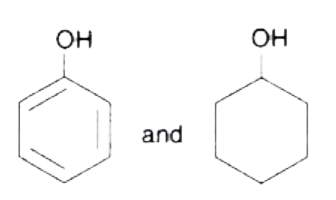Give one chemical test each to distinguish between the following pairs of compounds : Propanal and Propanone.
To distinguish between propanal (an aldehyde) and propanone (a ketone), we can perform a chemical test known as the Tollens' test. Here’s a step-by-step solution:
1. Identify the Compounds:
- Propanal (C3H6O) is an aldehyde with the structure CH3-CH2-CHO.
- Propanone (C3H6O), commonly known as acetone, is a ketone with the structure CH3-CO-CH3.
2. Prepare the Tollens' Reagent:
- Tollens' reagent is a solution of silver nitrate (AgNO3) in ammonia (NH3). It is often referred to as ammoniacal silver nitrate.
3. Perform the Test:
- Take a small amount of each compound (propanal and propanone) in separate test tubes.
- Add a few drops of Tollens' reagent to each test tube.
4. Observe the Reaction:
- Propanal (Aldehyde): When Tollens' reagent is added to propanal, a reaction occurs, resulting in the formation of a silver mirror on the inner surface of the test tube. This indicates the presence of an aldehyde.
- Propanone (Ketone): When Tollens' reagent is added to propanone, no reaction occurs, and no silver mirror is formed. This indicates the absence of an aldehyde.
5. Conclusion:
- The formation of a silver mirror confirms the presence of propanal (aldehyde), while the lack of reaction confirms the presence of propanone (ketone).
Final Answer:
The chemical test to distinguish between propanal and propanone is the Tollens' test. Propanal gives a positive result (silver mirror), while propanone gives a negative result (no silver mirror).
- Propanal (C3H6O) is an aldehyde with the structure CH3-CH2-CHO.
- Propanone (C3H6O), commonly known as acetone, is a ketone with the structure CH3-CO-CH3.
- Tollens' reagent is a solution of silver nitrate (AgNO3) in ammonia (NH3). It is often referred to as ammoniacal silver nitrate.
- Take a small amount of each compound (propanal and propanone) in separate test tubes.
- Add a few drops of Tollens' reagent to each test tube.
- Propanal (Aldehyde): When Tollens' reagent is added to propanal, a reaction occurs, resulting in the formation of a silver mirror on the inner surface of the test tube. This indicates the presence of an aldehyde.
- Propanone (Ketone): When Tollens' reagent is added to propanone, no reaction occurs, and no silver mirror is formed. This indicates the absence of an aldehyde.
- The formation of a silver mirror confirms the presence of propanal (aldehyde), while the lack of reaction confirms the presence of propanone (ketone).
The chemical test to distinguish between propanal and propanone is the Tollens' test. Propanal gives a positive result (silver mirror), while propanone gives a negative result (no silver mirror).
Topper's Solved these Questions
Similar Questions
Give chemical tests to distinguish between the following pairs of compounds :
Propanal and propanone.
View SolutionState chemical tests to distinguish between the following pairs of compounds :
Propanal and propanone
View Solution(a) Write the products of the following reactions :

(ii) CH3MgBr+CO2Dry ether−−−−−→H3O+
(iii) CH3CH2COOH+Br2Red Phosphorus−−−−−−−−−→
(b) Write simple chemical tests to distinguish between the following pairs of compounds :
(i) Propanal and propanone (ii) Benzaldehyde and Benzoic acid
View SolutionGive chemical tests to distinguish between the following pairs of compounds :
Propanal and propanone.
View SolutionGive chemical tests to distinguish between the following pairs of compounds :
Propanal and propanone.
View SolutionGive a chemical test to distinguish between the following pairs of compounds:

View SolutionGive one good chemical test to distinguish between the following pairs of compounds:
1-propanol and 2-propanol.
View SolutionGive one chemical test to distinguish between the following pairs of compounds :
Ethanol and 2 propanol.
View SolutionWrite chemical tests to distinguish between the following pairs of compounds :
Ethanal and propanal.
View SolutionGive simple chemical tests to distinguish between the following pairs of compounds :
(a) Ethanal and Propanal
(b) benzoic acid and phenol
View Solution